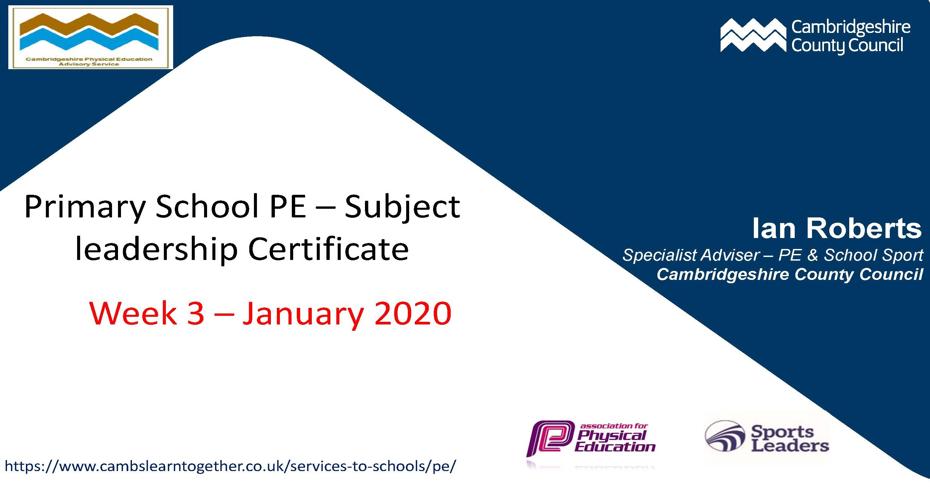
Creating a curriculum map / PE programme
Content
With the key learning goals, pedagogy and assessment strategies established, the 4th principle when planning curricula for physical education involves deciding on the actual content.
Reflective ActivityThink about your current method for planning units of work and address the following questions:
|
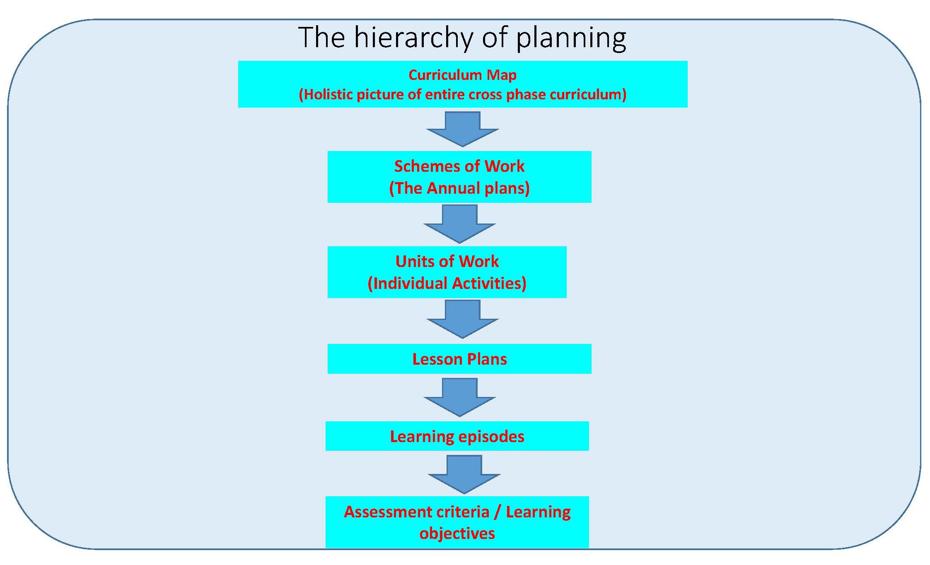
Stage one - Constructive Alignment
The first part of the content planning process is considering what it is that we want young people to learn!
The National Curriculum for Physical Education (DfE, 2013) is clear and succinct in the expectations for children at the end of each key stage.
Key Stage 1
‘Pupils should continue to develop fundamental movement skills, become increasingly competent and confident and access a broad range of opportunities to extend their agility, balance and co-ordination, individually and with others. They should be able to engage in competitive (both against self and against others) and co-operative physical activities, in a range of increasingly challenging situations’
Frapwell (2015) suggests that the end of key stage expectations can be broken down into learning concepts (the things we want children to learn) and mapped across the three domains described earlier i.e. Head, Heart and Hands
The learning concepts for KS1
|
Hands - Physical (psychomotor abilities) · Develop fundamental movement skills · Become increasingly competent & confident & access a broad range of opportunities · Extend agility, balance & coordination, individually & with others · Engage in competitive (against self & others) and cooperative physical activities in a range of increasingly challenging situation |
|
Head - Thinking (cognitive skills) · Able to make simple decisions and be aware of what they need to do to improve · Be creative when using and developing skills and tactics in simple sequences and activities |
|
Heart - Situational (socio-emotional adaptations): 1. Able to engage in competitive (against self & others) & cooperative physical activities in a range of increasingly challenging situations 2. Keen to participate in activities and clubs both in school and in the wider community |
The next part of stage 1 is to align those learning concepts into unit intentions and lesson outcomes/content.
Learning and Teaching Outcomes for KS 1
|
I can copy steps and actions with some control and co-ordination. |
I can stop/catch/ strike a ball with control and accuracy |
I can copy individual and whole body movements with some control and co-ordination. |
|
I can link individual and whole body movements together. |
I can pass a ball to someone else and receive a ball when moving |
I can link individual and whole body movements together. |
|
I can watch others work and choose actions. |
I can take part in sending and receiving activities with a partner |
I can watch others work. |
|
I can recognise how to move in space and I can talk about ways to keep healthy. |
I can talk about exercising, safety and short term effects of exercise |
I can recognise and negotiate space and I can handle small and/or low apparatus safely. |
It is clear that the outcomes in column 1 can be best linked to Dance type activities, column 2 to Games and Column 3 to Gymnastics, although there is a lot of overlap.
What must be stressed is that these outcomes should be established prior to deciding the content or context through which they will be taught, and not the other way round.
Stage 2 - Unit Selection
Once all of the learning and teaching outcomes, or intentions, have been established for a year group and/or a key stage, the challenge is to consider the most suitable content to support and challenge all pupils to achieve those outcomes.
This diagram shows how a Key Stage 1 unit focused on developing fundamental movement skills has been designed in this way. The unit shows from right to left, what the learning outcomes are for the unit, the type of activities selected to meet those criteria, and the learning objectives. These have been deliberately aligned into the three learning domains, but the connections must not be ignored.
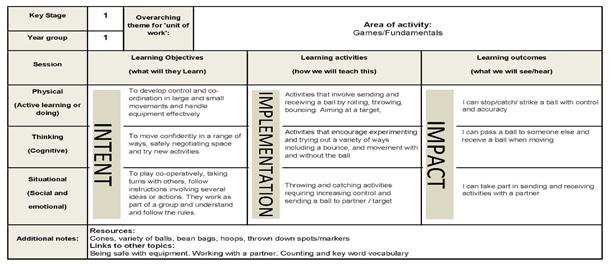
Reflective ActivityUse the 3 x 3 unit of work planner provided to plan a unit of work of your choice.
|
Stage 3 - Integrating Units into a Scheme of work
A unit of learning would be developed for each block that sits within the curriculum map, and these units would be integrated sequentially into year wide schemes of learning, rather like a jigsaw.
This diagram shows how this might look in practice with a scheme of work for Year 1, where the unit from above is the first area of learning in the Autumn term.
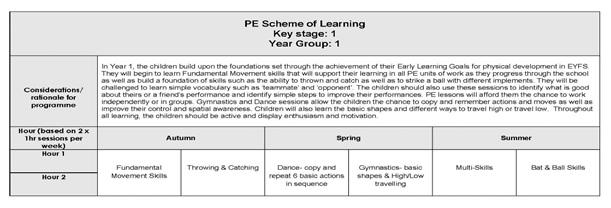
Reflective ActivityComplete a scheme of work template for one year group, with the unit prepared previously being integrated within it. |
Stage 4 - Linking it together into a curriculum Map
The planning process is repeated for each year group in turn and must consider progression and coherence, with concepts and themes revisited and built upon over time. Each scheme of learning aligns to create an integrated curriculum map, where connections can be made both vertically and horizontally, and the learning concepts can be effectively developed.
The diagram below shows a curriculum map, with all of the schemes of work, and so units of work aligning both horizontally and vertically.
Each Unit within this map, has an indication of the primary and secondary learning focus with a colour coding protocol.
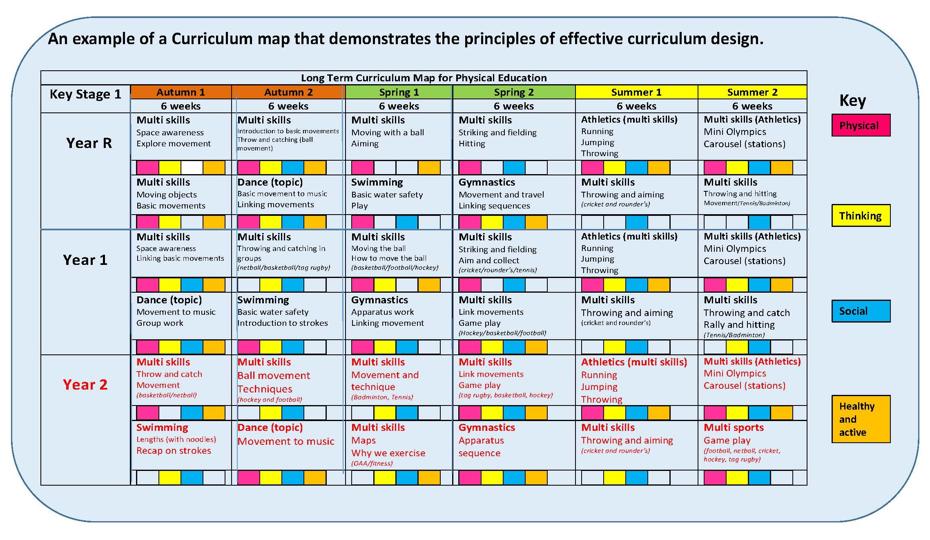
Reflective ActivityUsing the template provided, you need to devise a long term plan. You meed indicate which learning domain is best developed in each unit. If the domain is the main priority add that colour, if it is the secondary add the second . For example a Year 1 multi-skills unit may principally focus on gross and fine motor skills (hands) and secondarily on working together and sharing space (heart) |
Extending
The fifth key principle when planning curricula for physical education involves extending the offer so that all children and young people can further develop their knowledge and skills.
Some areas to reflect on include how to promote out-of-class learning opportunities, how inclusive is the extra-curricular or enrichment programme that is offered and how to embed cross-curricular links with other areas of the school curriculum.
If physical education is to be effective in preparing children and young people to lead active lifestyles, then they must be taught how to be active out-of-class. Consequently, teachers should signpost opportunities for physical activity both throughout the school day and also beyond the school gates.

